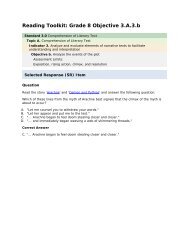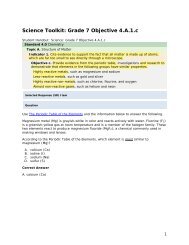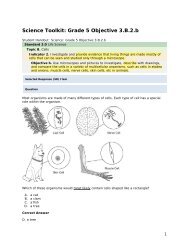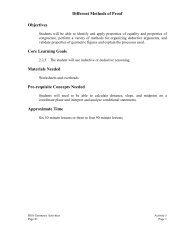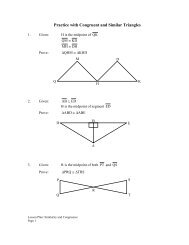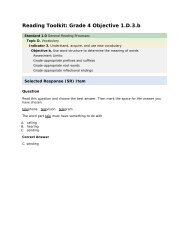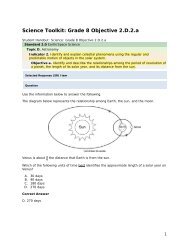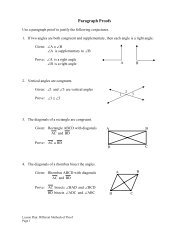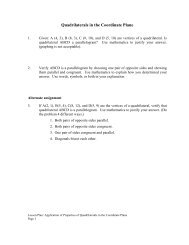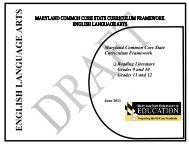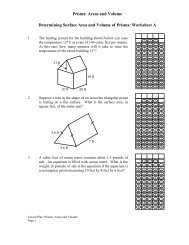HSA Biology Public Release 2005 - mdk12
HSA Biology Public Release 2005 - mdk12
HSA Biology Public Release 2005 - mdk12
You also want an ePaper? Increase the reach of your titles
YUMPU automatically turns print PDFs into web optimized ePapers that Google loves.
BIOLOGY<br />
<strong>Public</strong> <strong>Release</strong> <strong>2005</strong>
Copyright © <strong>2005</strong> by Maryland State Department of Education.<br />
This document was developed by Educational Testing Service under a contract with the Maryland State Department of<br />
Education, expressly for use by Maryland educators and citizens. Only Maryland educators and citizens may copy<br />
and/or download and print this document, located online at http://www.<strong>mdk12</strong>.org/. Any other use or reproduction<br />
of this document, in whole or in part, requires prior written approval of the Maryland State Department of Education.
Session 1<br />
Sample A<br />
Which of these instruments should<br />
a student use to measure the<br />
length of a housefly?<br />
Sample B<br />
Which of these systems directly<br />
provides support for the<br />
human body?<br />
A<br />
microscope<br />
F<br />
skeletal<br />
B<br />
metric ruler<br />
G<br />
excretory<br />
C<br />
funnel<br />
H<br />
endocrine<br />
D<br />
graduated cylinder<br />
J<br />
reproductive<br />
MDB00000<br />
MDB00000<br />
<strong>Biology</strong> <strong>Public</strong> <strong>Release</strong> <strong>2005</strong> Page 1<br />
Copyright © <strong>2005</strong> by Maryland State Department of Education.
Session<br />
1<br />
■1<br />
Students will conduct a laboratory experiment using the following materials: a<br />
Bunsen burner, a beaker of water, glass tubing, four test tubes containing different<br />
chemicals, and rubber stoppers. Which of these steps is most critical for students to<br />
follow when using these materials in the lab?<br />
A<br />
B<br />
C<br />
D<br />
wearing eye protection at all times<br />
writing the lab procedure in a notebook<br />
washing hands before starting the experiment<br />
placing a stopper on all test tubes before heating them<br />
■2<br />
(1)MDB00003<br />
Which of these are the repeating units that form a DNA molecule?<br />
F fatty acids<br />
G<br />
H<br />
J<br />
nucleotides<br />
amino acids<br />
chromosomes<br />
(2)MDB01173<br />
<strong>Biology</strong> <strong>Public</strong> <strong>Release</strong> <strong>2005</strong> Page 2<br />
Copyright © <strong>2005</strong> by Maryland State Department of Education.
Session<br />
1<br />
■3<br />
The table below shows the number<br />
of species of different types of<br />
simple land plants.<br />
NUMBER OF<br />
SIMPLE PLANT SPECIES<br />
Simple Plants<br />
Bryophytes<br />
Club mosses,<br />
spike mosses, and<br />
horsetails<br />
Number of<br />
Species<br />
20,000<br />
1,000<br />
■4<br />
A protein called p53 can keep<br />
cells from dividing. To prevent<br />
cell division, this protein<br />
most likely stops<br />
F<br />
G<br />
H<br />
J<br />
osmosis<br />
mitosis<br />
respiration<br />
mutation<br />
(2)MDB00985<br />
Ferns<br />
Total<br />
12,000<br />
33,000<br />
According to the table,<br />
approximately what proportion<br />
of all simple plant species are<br />
bryophytes?<br />
A 1 3<br />
B<br />
C<br />
1<br />
2<br />
2<br />
3<br />
D 3 4<br />
<strong>Biology</strong> <strong>Public</strong> <strong>Release</strong> <strong>2005</strong> Page 3<br />
Copyright © <strong>2005</strong> by Maryland State Department of Education.
Session<br />
1<br />
5<br />
BCR<br />
A student reads an advertisement from a fertilizer company. The advertisement<br />
claims their fertilizer increases the growth of tomato plants by 25 percent. The<br />
student decides to perform an experiment to test this claim. She performs the<br />
following procedure.<br />
1. Choose three similar-sized tomato plants.<br />
2. Plant each tomato plant in a small pot.<br />
3. Place all three small pots into one container and place on a window sill.<br />
4. Add fertilizer mixed with water to Plants 1 and 2.<br />
5. Add only water to Plant 3.<br />
6. Record the heights of the three plants after four weeks.<br />
The student’s results are shown in the table below.<br />
THE EFFECT OF FERTILIZER ON<br />
TOMATO PLANTS<br />
Plant<br />
1<br />
2<br />
3<br />
Height<br />
(centimeters)<br />
23<br />
20<br />
20<br />
Analyze the student’s experiment to determine if it supports the claims made in the<br />
fertilizer company’s advertisement. In your response, be sure to include<br />
• a description of the data needed to support the company’s claim<br />
• an explanation of the results of the student’s experiment<br />
• an evaluation of the student’s experiment<br />
• a description of any changes you would make to the experiment; explain your<br />
answer<br />
Write your answer in your Answer Book.<br />
<strong>Biology</strong> <strong>Public</strong> <strong>Release</strong> <strong>2005</strong> Page 4<br />
Copyright © <strong>2005</strong> by Maryland State Department of Education.
Session<br />
1<br />
D irections<br />
Use the information and the diagram below to answer Numbers 6 and 7.<br />
Starch turns blue-black in the presence of iodine solution. A selectively permeable<br />
dialysis sac containing a starch solution is placed into a beaker of iodine solution.<br />
Iodine solution<br />
Dialysis sac<br />
Starch solution<br />
■6<br />
If the dialysis sac is permeable<br />
only to water and iodine, what will<br />
the solutions in the beaker and the<br />
sac look like after two hours?<br />
F<br />
The iodine solution in the beaker<br />
will turn blue-black; the starch<br />
solution will not change.<br />
■7<br />
Which of these processes is<br />
demonstrated by the experiment<br />
shown in the diagram?<br />
A<br />
B<br />
C<br />
cellular respiration<br />
active transport<br />
endocytosis<br />
G<br />
The starch solution in the<br />
dialysis sac will turn blue-black;<br />
the iodine solution will not<br />
change.<br />
D<br />
diffusion<br />
H<br />
J<br />
Neither solution will turn<br />
blue-black.<br />
Both solutions will turn<br />
blue-black.<br />
<strong>Biology</strong> <strong>Public</strong> <strong>Release</strong> <strong>2005</strong> Page 5<br />
Copyright © <strong>2005</strong> by Maryland State Department of Education.
Session<br />
1<br />
■8<br />
A scientist is performing an investigation funded by a company. Which of these<br />
would be least likely to produce biased data?<br />
F<br />
G<br />
H<br />
J<br />
making the results please the company paying for the research<br />
being open minded and honest throughout the research project<br />
using only the data that supports the hypothesis<br />
using personal opinions to decide the results of the research<br />
(2)MDB01022<br />
<strong>Biology</strong> <strong>Public</strong> <strong>Release</strong> <strong>2005</strong> Page 6<br />
Copyright © <strong>2005</strong> by Maryland State Department of Education.
Session<br />
1<br />
■9<br />
The energy required for photosynthesis is provided by<br />
A<br />
proteins<br />
B<br />
C<br />
D<br />
sunlight<br />
chlorophyll<br />
carbohydrates<br />
(2)MDB01436<br />
<strong>Biology</strong> <strong>Public</strong> <strong>Release</strong> <strong>2005</strong> Page 7<br />
Copyright © <strong>2005</strong> by Maryland State Department of Education.
Session<br />
1<br />
D irections<br />
Use the technical passage below to answer Numbers 10 and 11.<br />
SHORTAGE OF HONEYBEES<br />
Honeybees are very important to agriculture. They produce honey and they pollinate many<br />
plants, making seed and fruit development possible. In recent years, severe weather and<br />
attacks by newly introduced insects have seriously affected both wild and domestic<br />
honeybee populations.<br />
Two species of mites entered North America around 1980. These mites weaken and kill<br />
honeybees by consuming their bodily fluids, blocking their respiratory passages, and<br />
spreading germs. European and South American honeybees developed an immunity to the<br />
effects of these mites. However, North American honeybees did not develop this immunity.<br />
By 1995, infestation with mites reached epidemic levels. In addition, the harsh winter of 1995<br />
to 1996 killed honeybee colonies in many states.<br />
Scientists have observed a significant decline in both wild and domestic honeybee<br />
populations. This loss affects beekeepers and farmers. Fifteen percent of all agricultural crops<br />
require bee pollination. Farmers have had to look for other species to pollinate their crops.<br />
Honeybees are not the only pollinators that have decreased in numbers. Many other insect<br />
and vertebrate pollinators throughout the world have been killed by the overuse of<br />
pesticides and habitat destruction. Many wild plants, including a number of endangered<br />
species, depend entirely on one animal species for pollination. The solutions to this<br />
“pollination crisis” are complex. It is clear that efforts to save threatened pollinators cannot<br />
be separate from efforts to preserve threatened plants and habitats.<br />
<strong>Biology</strong> <strong>Public</strong> <strong>Release</strong> <strong>2005</strong> Page 8<br />
Copyright © <strong>2005</strong> by Maryland State Department of Education.
Session<br />
1<br />
■10<br />
According to the passage, which of<br />
these is most responsible for the<br />
decline of honeybee populations?<br />
F<br />
G<br />
H<br />
an increase in pollution<br />
the use of bees to harvest honey<br />
the introduction of foreign<br />
species<br />
■12<br />
A sperm cell of a moth has<br />
112 chromosomes. How many<br />
chromosomes are in the moth’s<br />
wing cells?<br />
F 66<br />
G 112<br />
H 224<br />
J<br />
the use of bees to pollinate crops<br />
J 448<br />
■11<br />
(3)MDB01330<br />
South American honeybees are<br />
resistant to the mites. Scientists<br />
believe that the North American<br />
honeybees may also become<br />
resistant to the mites in another<br />
ten years.<br />
Which of these processes will cause<br />
the honeybee population to become<br />
resistant to the mites?<br />
(3)MDB00368<br />
A<br />
B<br />
C<br />
D<br />
natural selection<br />
chemosynthesis<br />
aerobic respiration<br />
succession<br />
(1)MDB01331<br />
<strong>Biology</strong> <strong>Public</strong> <strong>Release</strong> <strong>2005</strong> Page 9<br />
Copyright © <strong>2005</strong> by Maryland State Department of Education.
Session<br />
1<br />
13<br />
BCR<br />
There are approximately 14 species of bay grasses in Chesapeake Bay. Bay grasses<br />
provide a habitat for birds, fish, and shellfish. Most bay grasses grow attached to<br />
the bottom substrate in shallow water.<br />
Scientists estimate that the area covered by bay grasses once exceeded 600,000 acres.<br />
In 1978, scientists learned that bay grasses only covered 41,000 acres.<br />
Scientists began working to improve environmental conditions in the bay. They<br />
replanted bay grasses in some areas. They set a goal of having 110,000 acres of bay<br />
grasses by the year 2000. The data collected from yearly surveys of bay grasses is<br />
shown in the graph below.<br />
Acres of Bay Grass<br />
120,000<br />
100,000<br />
80,000<br />
60,000<br />
40,000<br />
20,000<br />
BAY GRASS COVERAGE IN CHESAPEAKE BAY<br />
(1984–2000)<br />
NO DATA<br />
Goal<br />
0<br />
2000<br />
1999<br />
1998<br />
1997<br />
1996<br />
1995<br />
1994<br />
1993<br />
1992<br />
1991<br />
1990<br />
1989<br />
1988<br />
1987<br />
1986<br />
1985<br />
1984<br />
Year<br />
Evaluate the success of this project. In your response, be sure to<br />
• predict the most likely value for the missing data in 1988; explain your answer<br />
• describe the trend in the area covered by bay grasses in Chesapeake Bay from<br />
1984 to 2000; use specific information from the graph to support your answer<br />
• suggest possible reasons for the changes in the graph between 1993 and 1995<br />
• describe ways that individuals can help in the restoration of bay grasses<br />
Write your answer in your Answer Book.<br />
<strong>Biology</strong> <strong>Public</strong> <strong>Release</strong> <strong>2005</strong> Page 10<br />
Copyright © <strong>2005</strong> by Maryland State Department of Education.
Session<br />
1<br />
D irections<br />
Use the information and the graph below to answer Numbers 14 and 15.<br />
A group of students studied the effect of light intensity on the rate of a cell process<br />
in Elodea plants. The students exposed Elodea plants to different light intensities. A<br />
gas was produced by the cell process. The amount of this gas was measured. The<br />
rate of the cell process was determined by the amount of gas produced. A graph of<br />
the students’ measurements is shown below.<br />
THE EFFECT OF LIGHT INTENSITY<br />
ON A CELL PROCESS IN ELODEA PLANTS<br />
Rate of Cell Process<br />
Light Intensity<br />
■14<br />
Which of these is the independent<br />
variable in this experiment?<br />
F<br />
G<br />
H<br />
J<br />
rate of cell process<br />
volume of gas<br />
size of Elodea plant<br />
intensity of light<br />
■15<br />
Which of these parts of the<br />
Elodea plant cell produces the gas<br />
measured in the experiment?<br />
A<br />
B<br />
C<br />
D<br />
mitochondrion<br />
chloroplast<br />
ribosome<br />
nucleus<br />
<strong>Biology</strong> <strong>Public</strong> <strong>Release</strong> <strong>2005</strong> Page 11<br />
Copyright © <strong>2005</strong> by Maryland State Department of Education.
Session<br />
1<br />
■16<br />
Which of these combinations results in the expression of a recessive trait?<br />
F<br />
two dominant alleles<br />
G<br />
H<br />
J<br />
a dominant sex-linked allele and a Y chromosome<br />
two recessive alleles<br />
a dominant allele and a recessive allele<br />
(3)MDB01465<br />
<strong>Biology</strong> <strong>Public</strong> <strong>Release</strong> <strong>2005</strong> Page 12<br />
Copyright © <strong>2005</strong> by Maryland State Department of Education.
Session<br />
1<br />
17<br />
BCR<br />
Scientists are studying how four species of deer are related. The scientists believe<br />
that Species 1 is the common ancestor. The four species have some traits in<br />
common. They also have traits that are unique to their species.<br />
Scientists used the process of gel electrophoresis to study the relatedness of the four<br />
deer species. The results of their gel electrophoresis study are shown below.<br />
ELECTROPHORESIS GEL<br />
OF DEER SPECIES<br />
Deer Species<br />
1<br />
(common<br />
2 3 4<br />
ancestor)<br />
Describe how three species of deer evolved from the common ancestor. In your<br />
response, be sure to<br />
• identify which species is most closely related to the common ancestor; explain<br />
your answer using the results of their gel electrophoresis<br />
• identify and describe the process that leads to the development of different<br />
species<br />
• explain what factors affect this process in the deer species<br />
Write your answer in your Answer Book.<br />
<strong>Biology</strong> <strong>Public</strong> <strong>Release</strong> <strong>2005</strong> Page 13<br />
Copyright © <strong>2005</strong> by Maryland State Department of Education.
Session<br />
1<br />
■18<br />
Certain plant crops are genetically engineered to grow faster and resist disease.<br />
These genetically engineered plant crops cannot reproduce because they have a<br />
“terminator” gene that keeps their seeds from sprouting. However, once the<br />
genetically engineered plant crops are planted outside, they may cross-pollinate<br />
with unaltered plant crops.<br />
The use of terminator genes is least likely to result in<br />
F<br />
G<br />
H<br />
J<br />
increased costs for seeds<br />
decreased varieties of food<br />
terminator genes spreading to other crops<br />
scientists being harmed from working with the terminator genes<br />
(4)MDB01382<br />
D irections<br />
Use the information and the diagrams below to answer Numbers 19 and 20.<br />
A student observed different types of cells under a microscope. Four of the cells he<br />
observed are shown below.<br />
Cell Wall<br />
Mitochondrion<br />
Nucleus<br />
Chloroplast<br />
Cell Wall<br />
Micronucleus<br />
Macronucleus<br />
Food Vacuole<br />
Cell 1 Cell 2 Cell 3 Cell 4<br />
■19 Which of these structures in Cell 3<br />
releases energy for use in cell<br />
processes?<br />
■20<br />
Cell 4 has many hair-like structures<br />
that it uses for movement. What are<br />
these structures called?<br />
A<br />
nucleus<br />
F<br />
cilia<br />
B<br />
cell wall<br />
G<br />
flagella<br />
C<br />
chloroplast<br />
H<br />
vacuoles<br />
D<br />
mitochondrion<br />
J<br />
pseudopodia<br />
<strong>Biology</strong> <strong>Public</strong> <strong>Release</strong> <strong>2005</strong> Page 14<br />
Copyright © <strong>2005</strong> by Maryland State Department of Education.
Session<br />
1<br />
■21<br />
Which of these organ systems is responsible for the removal of metabolic wastes<br />
from the blood?<br />
A<br />
B<br />
C<br />
D<br />
endocrine<br />
nervous<br />
respiratory<br />
excretory<br />
(4)MDB00981<br />
<strong>Biology</strong> <strong>Public</strong> <strong>Release</strong> <strong>2005</strong> Page 15<br />
Copyright © <strong>2005</strong> by Maryland State Department of Education.
Session<br />
1<br />
22<br />
BCR<br />
A population of sea urchins in a kelp forest ecosystem is being overfished. A<br />
team of students believe that a decline in the number of sea urchins will affect the<br />
organisms in the kelp forest ecosystem. The kelp forest food web below shows the<br />
relationships among the organisms in the kelp forest ecosystem.<br />
KELP FOREST FOOD WEB<br />
Northern Elephant Seals<br />
Horn Sharks<br />
Sea Otters<br />
Sea Urchins<br />
Kelp<br />
Kelp Crab<br />
The students believe that the kelp crab population will decrease if the sea urchin<br />
population decreases. Use the kelp forest food web to support or refute the<br />
students’ conclusion. In your response, be sure to<br />
• describe the roles of the kelp crab, sea otter, and sea urchin in the food web<br />
• describe the relationships between the kelp crab, sea otter, and sea urchin<br />
• explain how each organism in the food web would be affected by a change in<br />
the sea urchin population<br />
Write your answer in your Answer Book.<br />
<strong>Biology</strong> <strong>Public</strong> <strong>Release</strong> <strong>2005</strong> Page 16<br />
Copyright © <strong>2005</strong> by Maryland State Department of Education.
Session<br />
1<br />
D irections<br />
Use the information and the food chain below to answer Numbers 23 and 24.<br />
Cholera bacteria live inside copepods, tiny marine organisms. This type of<br />
microscopic bacteria harms the copepods by feeding off their internal tissues.<br />
Both of these organisms are found in oceans throughout the world. Unfavorable<br />
temperatures or salt levels may cause cholera bacteria to become inactive. When<br />
inactive, they do not feed or reproduce. When conditions become favorable, they<br />
become active once again.<br />
A cholera population may depend on the population of copepods in the<br />
surrounding water. A simple food chain showing this relationship is shown below.<br />
MARINE FOOD CHAIN<br />
Cholera bacteria<br />
Copepods<br />
Microscopic algae<br />
■23<br />
Cholera bacteria perform binary<br />
fission to<br />
A<br />
B<br />
C<br />
D<br />
reproduce asexually<br />
digest food rapidly<br />
regulate temperature<br />
increase body size<br />
■24<br />
Which of these describes the<br />
relationship between cholera<br />
bacteria and copepods?<br />
F<br />
G<br />
H<br />
J<br />
mutualism<br />
parasite–host<br />
commensalism<br />
producer–consumer<br />
<strong>Biology</strong> <strong>Public</strong> <strong>Release</strong> <strong>2005</strong> Page 17<br />
Copyright © <strong>2005</strong> by Maryland State Department of Education.
Session<br />
1<br />
■25<br />
Scientists are developing a microscopic submarine to deliver medicine to sites<br />
within the body. A biomotor that uses bacteria would move the submarine.<br />
The scientists are experimenting with several species of bacteria to find which one<br />
works best in the biomotor.<br />
Which of these is the dependent variable in the scientists’ experiment?<br />
A<br />
B<br />
C<br />
D<br />
the species of bacteria<br />
the movement of the submarine<br />
the size of the submarine<br />
the sites within the body<br />
■26<br />
(2)MDB01380<br />
A scientist cloned a goat. Which of these is a true statement about the cloned goat?<br />
F It has new genes and traits.<br />
G<br />
H<br />
J<br />
It lacks the genes for reproduction.<br />
It has genes that are identical to the original goat.<br />
It looks the same as the original goat but has different genes.<br />
(3)MDB00822<br />
<strong>Biology</strong> <strong>Public</strong> <strong>Release</strong> <strong>2005</strong> Page 18<br />
Copyright © <strong>2005</strong> by Maryland State Department of Education.
Session<br />
1<br />
■27<br />
Hemoglobin is an important protein in red blood cells. The DNA code for<br />
hemoglobin contains the following segment:<br />
TGC-GGA-CTC-CTC<br />
Which of these is the messenger RNA code for this segment of DNA?<br />
A<br />
B<br />
C<br />
D<br />
ACG-CCT-GAA-GAA<br />
TCC-GGT-CTC-CTC<br />
ACG-CCU-GAG-GAG<br />
UGC-GGA-CUC-CUC<br />
■28<br />
(3)MDB01175<br />
Reproductive cells are produced during<br />
F mitosis<br />
G<br />
H<br />
J<br />
meiosis<br />
fertilization<br />
budding<br />
(2)MDB01407<br />
<strong>Biology</strong> <strong>Public</strong> <strong>Release</strong> <strong>2005</strong> Page 19<br />
Copyright © <strong>2005</strong> by Maryland State Department of Education.
No test material on this page<br />
Page 20
Session 2<br />
<strong>Biology</strong> <strong>Public</strong> <strong>Release</strong> <strong>2005</strong> Page 21<br />
Copyright © <strong>2005</strong> by Maryland State Department of Education.
Session<br />
2<br />
D irections<br />
Use the information below to<br />
answer Numbers 29 and 30.<br />
31<br />
BCR<br />
How is carbon related to the flow of<br />
energy between the environment<br />
and organisms?<br />
■29<br />
A team of marine scientists is<br />
studying biotic and abiotic factors<br />
that affect the stability of a<br />
deep-sea ecosystem.<br />
The scientists discovered a species<br />
of fish that eats other fish and<br />
decaying matter. Which of these<br />
does not describe the newly<br />
discovered fish?<br />
A<br />
B<br />
consumer<br />
predator<br />
• Name the carbon compound that<br />
is exchanged between plants and<br />
their environment.<br />
• Describe how plants use carbon<br />
from the atmosphere to create<br />
more complex molecules.<br />
• Describe how animals that eat<br />
plants change these molecules<br />
and return carbon to the<br />
atmosphere.<br />
Write your answer in your Answer<br />
Book.<br />
■30<br />
C<br />
D<br />
scavenger<br />
producer<br />
(4)MDB01188<br />
The deep-sea ecosystem is a stable<br />
ecosystem. Which of these is a<br />
characteristic of most stable<br />
ecosystems?<br />
■32<br />
(~)MDB01042<br />
Which of these will most likely<br />
result in variation within a species?<br />
F<br />
G<br />
H<br />
mutation<br />
succession<br />
diffusion<br />
F<br />
G<br />
H<br />
J<br />
They contain a wide variety of<br />
organisms.<br />
They contain very few<br />
organisms.<br />
Organic nutrients are in short<br />
supply.<br />
Sunlight is not used to make<br />
food.<br />
J<br />
competition<br />
(1)MDB01517<br />
(1)MDB01185<br />
<strong>Biology</strong> <strong>Public</strong> <strong>Release</strong> <strong>2005</strong> Page 22<br />
Copyright © <strong>2005</strong> by Maryland State Department of Education.
Session<br />
2<br />
■33<br />
Cells in the stomach produce pepsin, an enzyme, to help digest food. Pepsin works<br />
best at a pH of 2. Which of these graphs most likely shows what will happen to the<br />
activity of pepsin as the pH of the stomach is increased?<br />
A<br />
EFFECT OF pH<br />
ON PEPSIN ACTIVITY<br />
C<br />
EFFECT OF pH<br />
ON PEPSIN ACTIVITY<br />
Pepsin Activity<br />
0 1 2 3 4<br />
pH<br />
B<br />
EFFECT OF pH<br />
ON PEPSIN ACTIVITY<br />
Pepsin Activity<br />
Pepsin Activity<br />
0 1 2 3 4<br />
pH<br />
D<br />
EFFECT OF pH<br />
ON PEPSIN ACTIVITY<br />
Pepsin Activity<br />
0 1 2 3 4<br />
0 1 2 3 4<br />
pH<br />
pH<br />
<strong>Biology</strong> <strong>Public</strong> <strong>Release</strong> <strong>2005</strong> Page 23<br />
Copyright © <strong>2005</strong> by Maryland State Department of Education.
Session<br />
2<br />
D irections<br />
Use the information and the figure below to answer Numbers 34 through 36.<br />
Scientists have recently discovered hydrothermal vent communities on the ocean<br />
floor. A diagram of a hydrothermal vent community is shown in the figure below.<br />
HYDROTHERMAL VENT COMMUNITY<br />
Vent Fish<br />
Sulfide-Rich<br />
Hot Water<br />
Vent<br />
Vent<br />
Vent<br />
Giant Tubeworms<br />
Limpets<br />
Polychaete Worms<br />
Octopus<br />
Giant White Clams<br />
Galatheid Crabs<br />
The organisms in this community live near heated vents. Inorganic compounds<br />
such as sulfides mix with extremely hot water when they are released from the<br />
vents. Bacteria use the sulfides to make food for themselves and other animals.<br />
Many of these bacteria live in the bodies of the giant tubeworms and the giant<br />
white clams that live in this community.<br />
<strong>Biology</strong> <strong>Public</strong> <strong>Release</strong> <strong>2005</strong> Page 24<br />
Copyright © <strong>2005</strong> by Maryland State Department of Education.
Session<br />
2<br />
■34<br />
Hydrothermal vent communities are<br />
often destroyed by lava erupting<br />
from the ocean floor. After the lava<br />
has cooled, different organisms<br />
begin to inhabit the area. Over a<br />
period of a few years, organisms<br />
inhabit the area in the following<br />
order:<br />
sulfur bacteria → crabs→ giant<br />
tubeworms → clams and mussels<br />
■36<br />
Which of these is an abiotic factor<br />
that influences this ecosystem?<br />
F<br />
G<br />
H<br />
J<br />
food<br />
bacteria<br />
water temperature<br />
giant tubeworms<br />
Which of these best identifies this<br />
sequence of events?<br />
F<br />
G<br />
H<br />
evolution<br />
mutation<br />
succession<br />
■35<br />
J<br />
translation<br />
The bacteria that live in the bodies<br />
of the giant tubeworms and the<br />
giant white clams are classified as<br />
A<br />
B<br />
C<br />
D<br />
eukaryotes<br />
prokaryotes<br />
plants<br />
fungi<br />
<strong>Biology</strong> <strong>Public</strong> <strong>Release</strong> <strong>2005</strong> Page 25<br />
Copyright © <strong>2005</strong> by Maryland State Department of Education.
Session<br />
2<br />
■37<br />
Amylase is an enzyme that allows the human body to digest starch. Which of these<br />
diagrams best represents part of the structure of amylase?<br />
A sugar sugar sugar<br />
nucleotide<br />
nucleotide<br />
B<br />
nucleotide<br />
nucleotide<br />
nucleotide<br />
nucleotide<br />
C amino acid amino acid amino acid amino acid<br />
fatty acid<br />
D<br />
glycerol<br />
fatty acid<br />
fatty acid<br />
<strong>Biology</strong> <strong>Public</strong> <strong>Release</strong> <strong>2005</strong> Page 26<br />
Copyright © <strong>2005</strong> by Maryland State Department of Education.
Session<br />
2<br />
38<br />
BCR<br />
Galactosemia is an inherited<br />
disorder in humans. A person with<br />
the disorder cannot digest the<br />
sugars in milk. The allele for<br />
normal digestion (G) is dominant;<br />
the allele for galactosemia (g) is<br />
recessive.<br />
A female who is heterozygous for<br />
the galactosemia trait and a male<br />
who has galactosemia have a child.<br />
Describe how this disorder could<br />
have been passed on in the family.<br />
In your response, be sure to<br />
■39<br />
Nitrogen compounds are a part of<br />
all organisms. What happens to the<br />
nitrogen in an organism after it<br />
dies?<br />
A<br />
B<br />
C<br />
D<br />
It is destroyed by<br />
decomposition.<br />
It is recycled and used by other<br />
organisms.<br />
It remains trapped in the<br />
organism’s tissues.<br />
It is all used up by the time the<br />
organism dies.<br />
• identify the genotype of the<br />
father<br />
(2)MDB00880<br />
• complete a Punnett square to<br />
show the possible genotypes and<br />
phenotypes of the child<br />
• describe the probability that the<br />
child will inherit galactosemia<br />
• describe all the possible<br />
genotypes and phenotypes of the<br />
father’s parents; explain your<br />
answer<br />
Write your answer in your Answer<br />
Book.<br />
(~)MDB01492<br />
<strong>Biology</strong> <strong>Public</strong> <strong>Release</strong> <strong>2005</strong> Page 27<br />
Copyright © <strong>2005</strong> by Maryland State Department of Education.
Session<br />
2<br />
■40<br />
The global water cycle consists of water circulating among the land, the<br />
atmosphere, the oceans, and organisms. Trees get most of their water directly from<br />
F<br />
G<br />
H<br />
J<br />
lakes<br />
air<br />
streams<br />
soil<br />
(4)MDB00791<br />
<strong>Biology</strong> <strong>Public</strong> <strong>Release</strong> <strong>2005</strong> Page 28<br />
Copyright © <strong>2005</strong> by Maryland State Department of Education.
Session<br />
2<br />
■41<br />
Which of these is produced as a result of fertilization?<br />
A<br />
a zygote with twice the number of chromosomes as a gamete<br />
B<br />
C<br />
D<br />
an egg with half the number of chromosomes as a zygote<br />
a gamete with twice the number of chromosomes as a zygote<br />
a zygote with half the number of chromosomes as a gamete<br />
(1)MDB01574<br />
<strong>Biology</strong> <strong>Public</strong> <strong>Release</strong> <strong>2005</strong> Page 29<br />
Copyright © <strong>2005</strong> by Maryland State Department of Education.
Session<br />
2<br />
D irections<br />
Use the information and the food web below to answer Numbers 42 and 43.<br />
Part of the food web in Yellowstone National Park is shown below.<br />
YELLOWSTONE NATIONAL PARK FOOD WEB<br />
Gray Wolf<br />
Coyote<br />
Vole<br />
Elk<br />
Grass, Grain, Fruits<br />
Gray wolves were reintroduced into Yellowstone National Park in 1995. Two years<br />
later, the population of coyotes had decreased by 50%. Coyotes were found in all<br />
habitats of the park before the gray wolves were reintroduced. Now, coyotes are<br />
most often found in the hills and mountains.<br />
<strong>Biology</strong> <strong>Public</strong> <strong>Release</strong> <strong>2005</strong> Page 30<br />
Copyright © <strong>2005</strong> by Maryland State Department of Education.
Session<br />
2<br />
■42<br />
Coyotes and gray wolves have a high degree of relatedness. Which of<br />
these best describes why the two species are closely related?<br />
F<br />
G<br />
H<br />
J<br />
They have similar behaviors.<br />
They have a common ancestor.<br />
They feed on the same types of food.<br />
They are found in the same habitat.<br />
■43<br />
Which of these describes the role of the vole in the Yellowstone ecosystem?<br />
A<br />
decomposer<br />
B<br />
C<br />
D<br />
producer<br />
herbivore<br />
carnivore<br />
■44<br />
Scientists estimate that 200 non-native organisms have been introduced into<br />
Chesapeake Bay. Which of these statements is not true about non-native organisms?<br />
F<br />
G<br />
H<br />
J<br />
They often form mutualistic relationships with native organisms.<br />
They can deplete the food sources of native organisms.<br />
They are often aggressive at acquiring and maintaining territory.<br />
They can prey on native organisms causing them to go extinct.<br />
(1)MDB01379<br />
<strong>Biology</strong> <strong>Public</strong> <strong>Release</strong> <strong>2005</strong> Page 31<br />
Copyright © <strong>2005</strong> by Maryland State Department of Education.
Session<br />
2<br />
D irections<br />
The diagram below shows the key steps for making proteins. Use the diagram to<br />
answer Numbers 45 through 47.<br />
I<br />
II<br />
III<br />
IV<br />
Finished Protein<br />
■45<br />
According to the diagram, in<br />
which step is messenger RNA<br />
being constructed?<br />
A<br />
B<br />
C<br />
D<br />
I<br />
II<br />
III<br />
IV<br />
■46<br />
■47<br />
Which step involves transfer RNA?<br />
F I<br />
G II<br />
H III<br />
J IV<br />
Which step involves ribosomes?<br />
A I<br />
B<br />
C<br />
D<br />
II<br />
III<br />
IV<br />
<strong>Biology</strong> <strong>Public</strong> <strong>Release</strong> <strong>2005</strong> Page 32<br />
Copyright © <strong>2005</strong> by Maryland State Department of Education.
Session<br />
2<br />
48<br />
BCR<br />
Mammals are exposed to a variety of outside temperatures. However, they are able<br />
to maintain a constant internal body temperature.<br />
Describe ways that mammals warm and cool themselves in response to their<br />
environment.<br />
Include in your response<br />
• an example of a mammal and its environment<br />
• both body structures and activities they use<br />
• specific examples of both warming and cooling<br />
Write your answer in your Answer Book.<br />
■49<br />
(~)MDB01053<br />
Which of these body systems transports glucose and other substances in the blood<br />
to the cells of the body?<br />
A<br />
B<br />
C<br />
D<br />
digestive system<br />
endocrine system<br />
circulatory system<br />
reproductive system<br />
(3)MDB00945<br />
<strong>Biology</strong> <strong>Public</strong> <strong>Release</strong> <strong>2005</strong> Page 33<br />
Copyright © <strong>2005</strong> by Maryland State Department of Education.
Session<br />
2<br />
■50<br />
Reef-building coral are marine animals with single-celled algae living in their<br />
tissues. The coral provide protection for the algae and the algae provides food for<br />
the coral. Which of these statements best explains what would happen to the coral<br />
if the algae die?<br />
F<br />
G<br />
H<br />
J<br />
The coral would grow well because it does not have a competitor.<br />
The coral would die because it needs the food produced by the algae.<br />
The coral would grow well because it does not have a parasite.<br />
The coral would die because it cannot produce food for the algae.<br />
(2)MDB01138<br />
D irections<br />
Use the information and food chain below to answer Numbers 51 and 52.<br />
A summer camp was built near a lake in the mountains. The campers used the lake<br />
for swimming, fishing, and boating. The relationships between three organisms<br />
found in the lake are shown below.<br />
LAKE FOOD CHAIN<br />
Algae Striped Fish Spotted Fish<br />
■51<br />
Which of these fish cell structures<br />
would be most directly affected by<br />
a change in the oxygen level of the<br />
lake?<br />
■52<br />
Striped fish are affected by<br />
biotic and abiotic factors in their<br />
environment. Which of these<br />
factors is biotic?<br />
A<br />
mitochondrion<br />
F<br />
water temperature<br />
B<br />
chloroplast<br />
G<br />
mineral nutrients<br />
C<br />
golgi apparatus<br />
H<br />
freshwater algae<br />
D<br />
endoplasmic reticulum<br />
J<br />
inorganic sediments<br />
<strong>Biology</strong> <strong>Public</strong> <strong>Release</strong> <strong>2005</strong> Page 34<br />
Copyright © <strong>2005</strong> by Maryland State Department of Education.
Session<br />
2<br />
■53<br />
A researcher recently discovered a species of bacteria. DNA sequences were<br />
obtained from it and from several other species of bacteria. The DNA sequences<br />
came from the same part of the bacterial chromosome of each species.<br />
DNA Sequence<br />
Unknown Species<br />
ACT<br />
GCA<br />
GCC<br />
Species I<br />
ACA<br />
GCG<br />
CCG<br />
Species II<br />
ACT<br />
GCT<br />
GGC<br />
Species III<br />
ACA<br />
GCC<br />
GGG<br />
Species IV<br />
ACT<br />
GCA<br />
GCG<br />
According to the data above, the unknown bacteria are most closely related to<br />
which species?<br />
A<br />
B<br />
C<br />
D<br />
Species I<br />
Species II<br />
Species III<br />
Species IV<br />
<strong>Biology</strong> <strong>Public</strong> <strong>Release</strong> <strong>2005</strong> Page 35<br />
Copyright © <strong>2005</strong> by Maryland State Department of Education.
BIOLOGY<br />
<strong>Public</strong> <strong>Release</strong> <strong>2005</strong>




